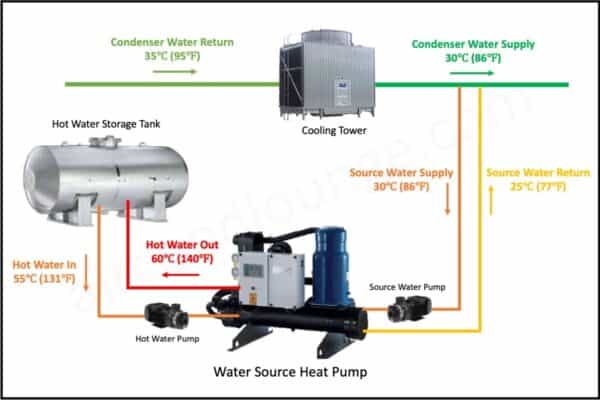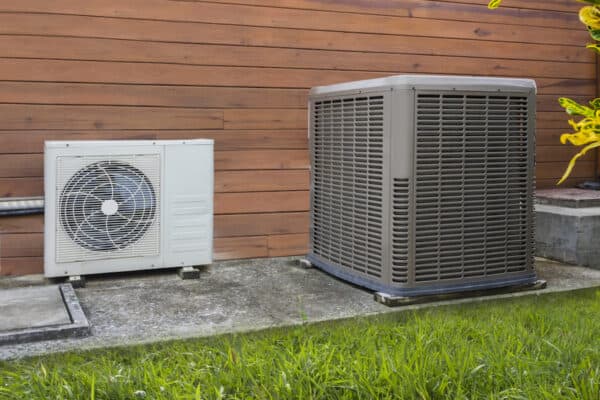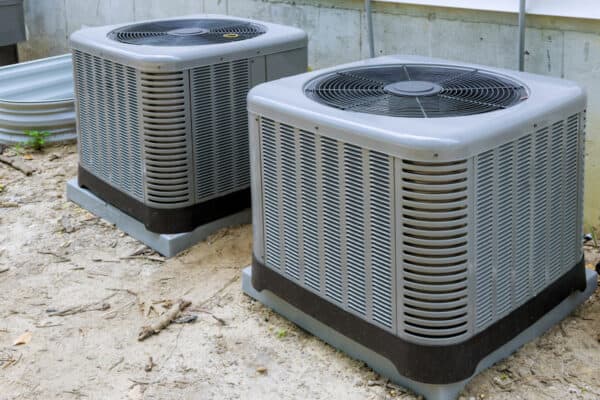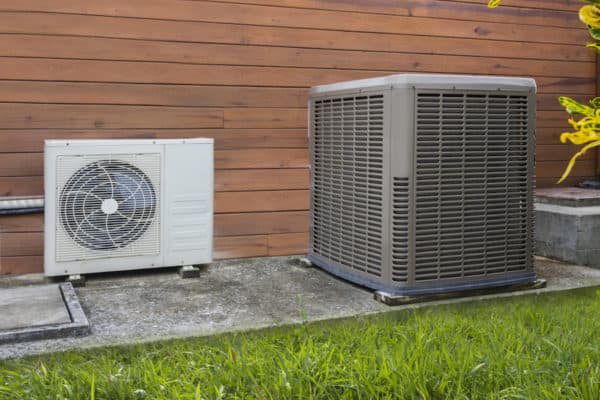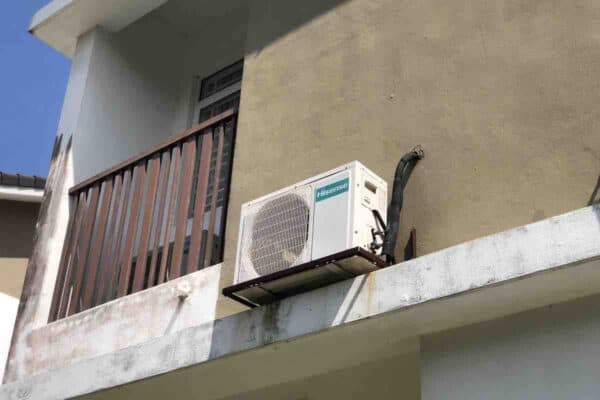How Heat Pump Water Heaters Work?
More and more people are using heat pump water heaters to produce hot water for showers nowadays. They are said to be better and more efficient than traditional water heaters. So, let’s find out how it works and how does it compare to other water heaters.
Heat pump water heaters are also known as hot water heat pumps. Heat pump water heaters use the refrigeration cycle to produce hot water rather than using resistive heating or burning fossil fuels and natural gas. Hence, they are more energy-efficient.
I happened to be working on a few commercial heat pump hot water systems. So, without further ado, let’s start with the working principle of heat pump water heaters.
Heat Pump Water Heater Working Principle
Heat pump water heaters work by harvesting the heat energy from the ambient air and transferring it to the water thereby heating the water sufficient enough for a good relaxing shower.
There are two major components in a heat pump water heater; a) heat pump and b) hot water storage tank. Most heat pumps used for hot water generation are air to water heat pumps. I explained the components, operation and configuration of air to water heat pumps in my previous blog post.
Below is a labeled photo to show you the connection between air-to-water heat pump (air-source heat pump) and a hot water storage tank:

Domestic cold water or the incoming cold water at your house enters the hot water storage tank and fills up the tank. The heat pump has a temperature sensor inserted into the storage tank. When it detects low water temperature, the circulation pump built inside the heat pump will operate to circulate the water between the heat pump and the storage tank.
The cold water from the storage tank goes inside the heat pump where it passes through a brazed plate heat exchanger (usually) and absorbs the heat of the refrigerant before returning back to the storage tank.
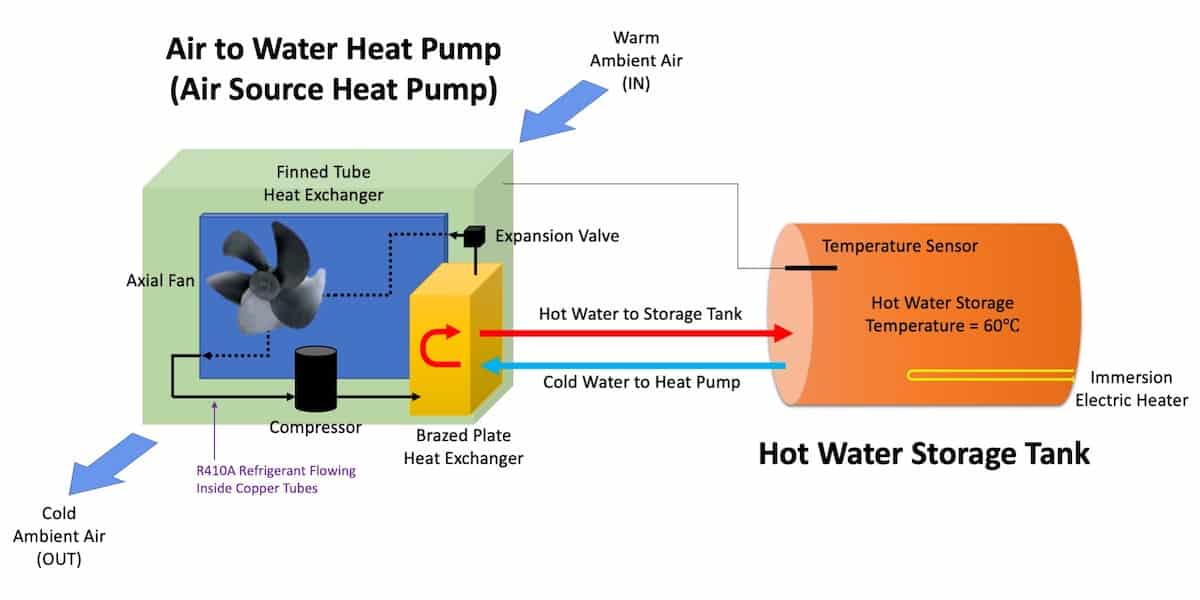
Inside the heat pump, it is very similar to air conditioners. Hot water heat pumps use the refrigeration cycle just like air conditioners. They have 4 major components as follow:
- Compressor
- Condenser (brazed plate heat exchanger)
- Expansion valve
- Evaporator (finned tube heat exchanger)
The compressor of the hot water heat pump compresses the refrigerant and sends it to the brazed plate heat exchanger. Inside the heat exchanger, heat is transferred from the refrigerant to the water. The refrigerant and the water is not in contact.
See how plate heat exchangers work:
Then, the refrigerant gets expanded by the expansion valve and passes through the finned tube heat exchanger where the axial fan draws in ambient air such that the refrigerant can absorb (or harvest) heat from the ambient air. Finally, the refrigerant circulates back to the compressor and the cycle repeats.
Actually, hot water heat pumps are even closer to HVAC heat pumps in terms of components and the working principle. See my blog post on how heat pumps work in winter to understand how heat can be harvested from cold ambient.
At the brazed plate heat exchanger (or condenser), the cold water from the hot water storage tank is usually heating up around 5°C every time it passes through (delta T 5°C). So, it takes some time for the entire storage tank to raise from 26°C to 60°C, assuming the incoming cold water temperature is 26°C.
“Water keeps circulating between the heat pump and the storage tank until it reaches the desired temperature.”
Most of the time, the hot water is kept at not more than 60°C for safety reasons. However, it is essential that the heat pump system maintain the hot water at a temperature of at least 50°C because of the Legionella disease that grows best from 25°C to 45°C.
Sometimes, hot water storage tanks have an immersion electric heater to serve as a backup in case the heat pump breakdown. It can be interlocked with heat pumps for auto change over but the manual operation is usually recommended.
Usually, PPR pipes or copper pipes are used for the connection between heat pumps and storage tanks in the heat pump hot water system. However, stainless steel pipes can be used when high corrosion resistance is needed in exchange for high material costs.
The R410 refrigerant is the most common refrigerant used in heat pump water heaters. Besides, many heat pump water heaters are using the R134a refrigerant.
Pros and Cons of Heat Pump Water Heater
Heat pump water heaters are best known for their energy efficiency. A traditional tankless or storage electric heater has a COP (coefficient of performance) of 1 only. Meanwhile, most heat pumps have a COP of around 3.5.
Below is a table comparing the hot water heat pump and other types of water heaters:
| Comparison | Heat Pump | Tankless | Storage (Electric) | Gas Boiler |
|---|---|---|---|---|
| Energy Cost | Low | High | High | Medium |
| Purchase Cost | High | Low | Low | High |
| Repair Cost | Medium | Low | Low | High |
| Occupy Space | Big | Small | Medium | Medium |
| Environmental | Eco-friendly | Low efficiency | Low efficiency | High carbon emission |
Heat pumps are fundamentally more energy-efficient than pure electric heaters. They harvest “free energy” from the ambient air and transfer it into producing hot water.
Heat Pump Water Heater vs Tankless Water Heater
Because heat pump water heaters are more efficient, they use less energy (electricity) than tankless water heaters. At the same time, they are less harmful to the environment.
However, heat pump water heaters are more expensive to purchase and repair than tankless water heaters because they are more complicated and consist of more components. Furthermore, heat pumps occupy a bigger space since they have two separate equipment.
But, tankless water heaters require a bigger cable size than heat pump water heaters because they run at a higher amperage. Besides, the circuit breaker and other electrical components associated with the tankless water heater also need to be sized bigger as well.
In commercial buildings, the weakness of tankless water heaters is amplified. Because they draw a high amount of electrical current instantaneously, electrical surge management must be done well to prevent tripping and blackout.
Heat Pump Water Heater vs Electric Storage Heater
Electric storage heaters also use pure electric heaters to produce hot water. So, they consume as much power as tankless water heaters. However, electric storage heaters always store hot water. Thus, heat loss is making them even less efficient than tankless water heaters.
On the other hand, heat pump water heaters also experience heat loss since they also store hot water inside hot water storage tanks. However, they produce hot water much more efficiently than electric storage heaters. Overall, heat pump water heaters are still much better than electric storage heaters in terms of energy efficiency.
Electric storage heaters are even less complicated than tankless water heaters. Hence, they are affordable, easy to use and easy to maintain as well as repair when necessary.
Heat Pump Water Heater vs Gas Boiler
The energy cost of gas boilers varies depending on location. Some places have a very low natural gas price which makes gas boilers a very appealing machine for hot water production. However, they are fundamentally bad for the environment.
In addition, gas boilers are capable of reaching beyond 60°C hot water temperature which is suitable for sanitization in hotels. However, they are required to be checked and serviced periodically by expensive boiler specialists.
Hot Water Stratification
For large hot water storage tanks, managing hot water stratification is very important in order to further improve the efficiency of the hot water system, especially for vertical tanks.
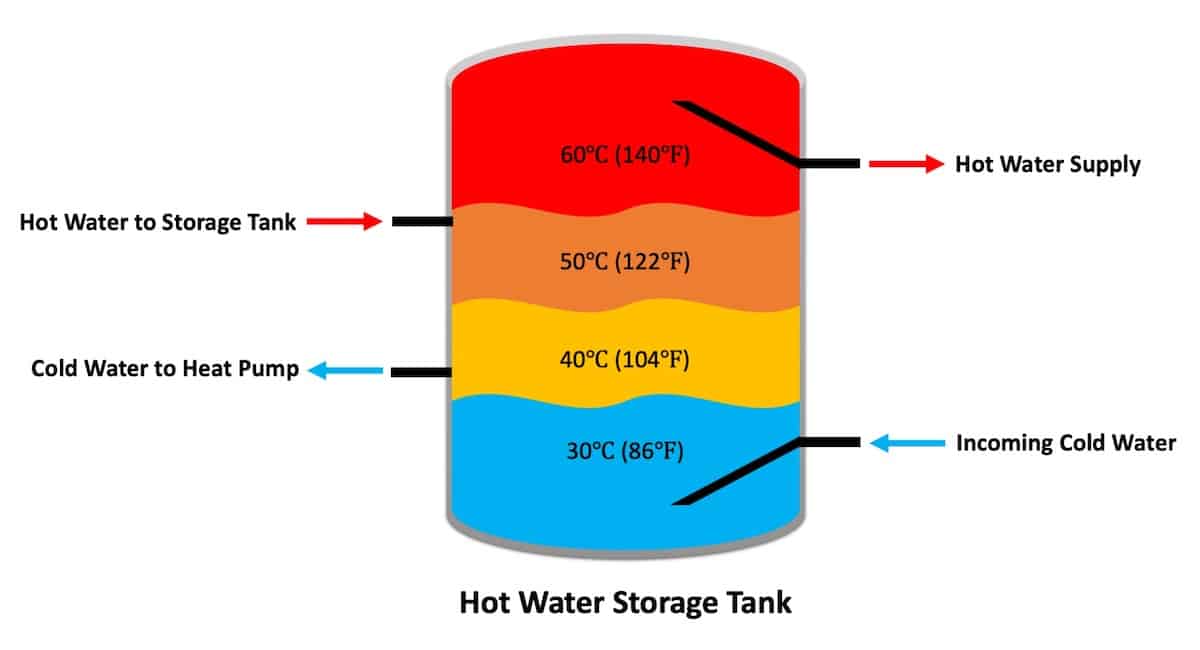
For hot water storage tanks, stratification means the difference in the water temperature from the top of the tank to the bottom of the tank as illustrated in the above diagram.
As you can see, we shouldn’t mix the cold water at the bottom of the tank with the hot water at the top of the tank. Hence, you can see divert pipes are built inside the storage tank to direct the cold water down and the hot water up so that they don’t stir up the whole tank.
When the hot water stratification is maintained, we will always be supplying hot water at the required temperature. Furthermore, the heat pumps will always yield the best COP because the water temperature going into the heat pumps is lower.
If the hot water stratification is not maintained, we will still be supplying 60°C hot water at first. But, after a while, the cold water starts to stir up the whole thing, resulting in the supplying the hot water at below 60°C which forces the user to increase the hot water flow rate. Consequently, hot water usage is higher and electricity consumption is higher.
Heat Pump Water Heater Temperature Control
As mentioned earlier, the heat pump temperature sensor is inserted inside the storage tank to measure the hot water temperature. Thus, heat pump water heaters control the hot water temperature with the sensor and usually, with a display controller.
You can set your desired hot water temperature at the display controller of the heat pump. If you set it to 60°C, it will cut-in at 55°C or 5°C below the setpoint temperature. It will then cut-off when the hot water is heated back to 60°C.
By default, most heat pump water heaters have a temperature setpoint of 55-60°C, meaning 55°C cut-in and 60°C cut-off. Some people prefer to change the setting to 50-55°C in order to conserve energy. The higher the hot water temperature, the higher the power consumption due to low heat pump efficiency.
Pipe and Tank Insulation
Insulations are absolutely critical in the hot water system. The PPR pipes or copper pipes used to transfer hot water in between heat pumps and storage tanks as well as bathrooms must be sufficiently insulated to prevent heat loss and overall poor energy efficiency.
Hot water storage tanks are usually insulated with at least 50mm (2″) thick PU insulation when placed indoors. For outdoor, the insulation thickness is raised to 75mm (2-1/2″). As for the pipes, the common insulation thickness is 25mm (1″), using closed-cell insulation or Armaflex/Superlon.
Conclusion
Heat pump water heaters are more expensive to buy than tankless and electric storage heaters. However, they consume lesser electricity and are better for the environment. Gas boilers may be cheaper to use but they are harmful to the environment.
Next, heat pump water heaters use the refrigeration cycle to harvest heat from the ambient air and transfer it to produce hot water. Then, they store the hot water inside insulated tanks.
Then, heat pump water heaters use their temperature sensor to control their operation. Most of the time, the hot water is kept at not more than 60°C for safety reasons. However, it is essential that the heat pump system maintain the hot water at a temperature of at least 50°C.
Lastly, hot water stratification, pipe and tank insulation are important to improve the efficiency of the hot water system.
If you have anything to add (or ask) about this topic, leave a comment down below!



